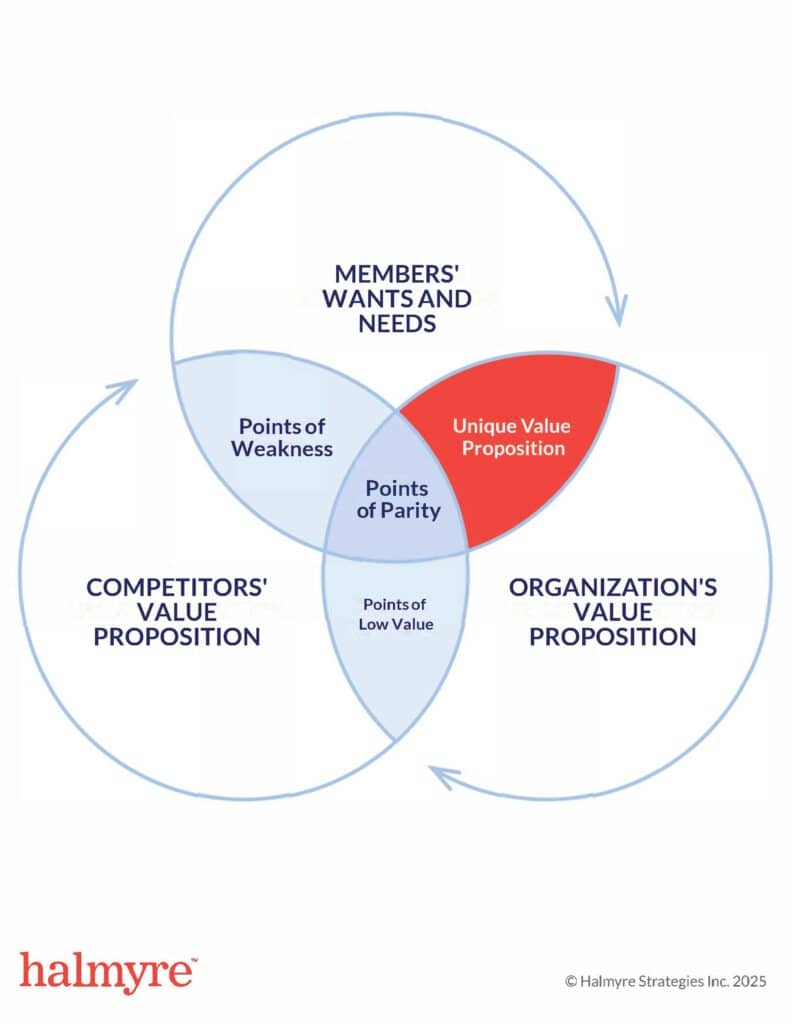Getting into the “Red Zone”: How Association Leaders Can Forge an Unshakeable Value Proposition

In an age of information overload and a marketplace teeming with choices, modern associations face a critical challenge: demonstrating their unique and irreplaceable value. Members are no longer simply joining for a directory listing, a monthly newsletter, or a discounted service; they are seeking a clear, compelling reason to invest their time, money, and professional identity. The key to meeting this demand lies in crafting a robust and differentiated value proposition.
 A value proposition is far more than a catchy slogan or a list of your association’s benefits. It is a precise, clear statement that answers three fundamental questions for your target audience:
A value proposition is far more than a catchy slogan or a list of your association’s benefits. It is a precise, clear statement that answers three fundamental questions for your target audience:
- What problem do you solve for me?
- How do you solve it better than anyone else? and
- What is the outcome I can expect?
For association leaders, this requires a shift in mindset from simply offering services to actively addressing the pain points and aspirations of your members.
This is where the concept of the “Red Zone” becomes critically important. As visualized in the Halmyre Value Proposition model, the Red Zone is the sweet spot where your association’s unique capabilities intersect with your members’ unmet needs, in an area where your competition is not a factor. This intersection is the ultimate source of a powerful value proposition. By defining and occupying this strategic space, you can move beyond simply competing on price or features and instead become an indispensable partner in your members’ professional lives.
To forge a value proposition that truly stands out, you must begin with deep empathy and a ruthless understanding of your ecosystem. Here are four critical steps to identifying and implementing a unique and differentiated Value Proposition:
Step 1: Know Your Audience, Not Just Their Demographics
The first and most critical step is to move beyond a surface-level understanding of your members. While it’s helpful to know their job titles and years of experience, a powerful value proposition is built on knowing their professional struggles. What keeps them up at night? Are they grappling with new regulations, a skills gap, or a lack of meaningful peer connections? How is the sector or industry they’re in evolving to meet today’s seismic technological and societal shifts? Your value proposition should speak directly to these challenges, proving that you are not just a resource but a partner in their success.
Step 2: Acknowledge and Analyze Your Competition
In today’s landscape, your competition isn’t just other associations. It’s the entire universe of professional development, networking, and information—from free online forums and low-cost webinars to well-funded training companies. Acknowledge these alternatives and analyze how they are meeting the needs of your members. Understanding their strengths and weaknesses allows you to identify your own unique competitive advantage.
Step 3: Articulate Your “Red Zone” Uniqueness
This is the core of differentiation. With a clear picture of your members’ needs and the competitive landscape, you can now define what you do better than anyone else. Perhaps you offer a unique, curated network of senior leaders that is impossible to replicate. Maybe your association is the sole authoritative voice advocating for the industry at a legislative level. It could be that your research and data are the most trusted in the field. Your value proposition resides at the intersection of member needs and your association’s specific capabilities.
Step 4: Communicate with Unwavering Clarity
Once you have defined your unshakeable core, you must communicate it clearly and consistently across every touchpoint. This includes your website, membership renewal materials, social media, and conference messaging. Every communication should reinforce your value proposition, serving as a reminder of the specific problem you solve and the unique way you solve it. This consistency builds trust and transforms a vague sense of value into a concrete and compelling reason to join and stay.
Conclusion: Value Propositions Deliver Confidence, Resilience
For an association, a strong value proposition is not just a strategic tool; it is a driver of sustainable growth. Research (such as this study of North American association executives) consistently shows that organizations with a clear value proposition are more confident and more successful. This foundational clarity empowers associations to increase customer engagement and loyalty, maximize revenue, and optimize pricing with confidence. Furthermore, a strong value proposition deepens an association’s resilience, strengthening its ability to deliver value to members even in challenging times.
Your Value Proposition is the North Star that guides your strategic decisions and ensures that every effort is directed towards a meaningful outcome for your members. By focusing on your unique, differentiated value and consistently communicating it, you can ensure your association doesn’t just survive, but thrives today and tomorrow.
Tags
Related Articles
Content governance: Setting up your content for success
Why and how to create smart, sustainable systems and processes for all the content your...
The Emergency Nurses Association Utilizes Design Thinking to Reimagine its Awards Ceremony
In a prime example of intrapreneurship, the ENA utilized design thinking to innovate within the...
Report Reveals Strategies to Overcome Membership Decline
McKinley Advisors’ Membership Reset report provides a roadmap that association leaders can use to refocus...




